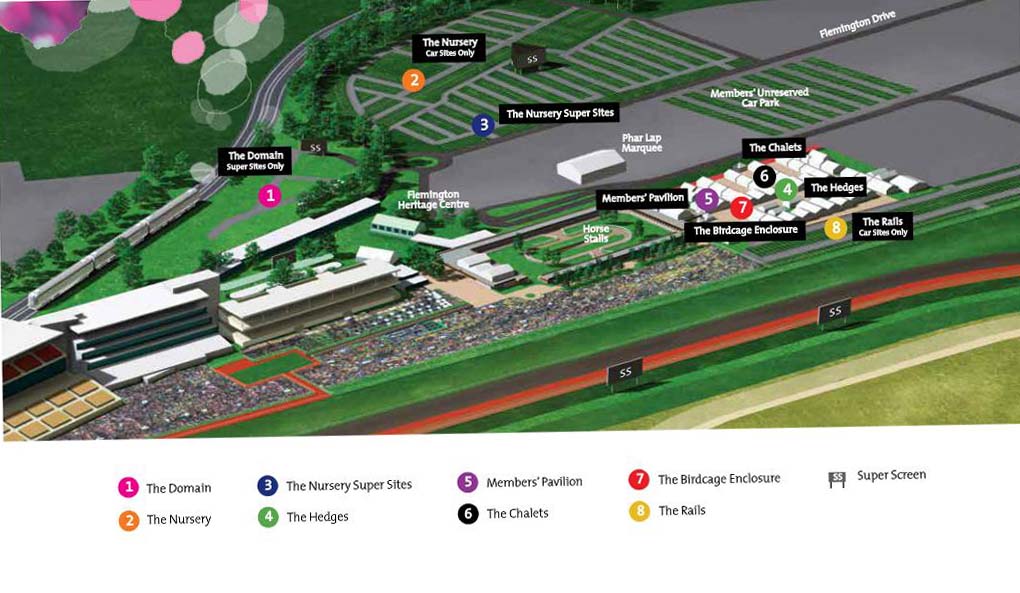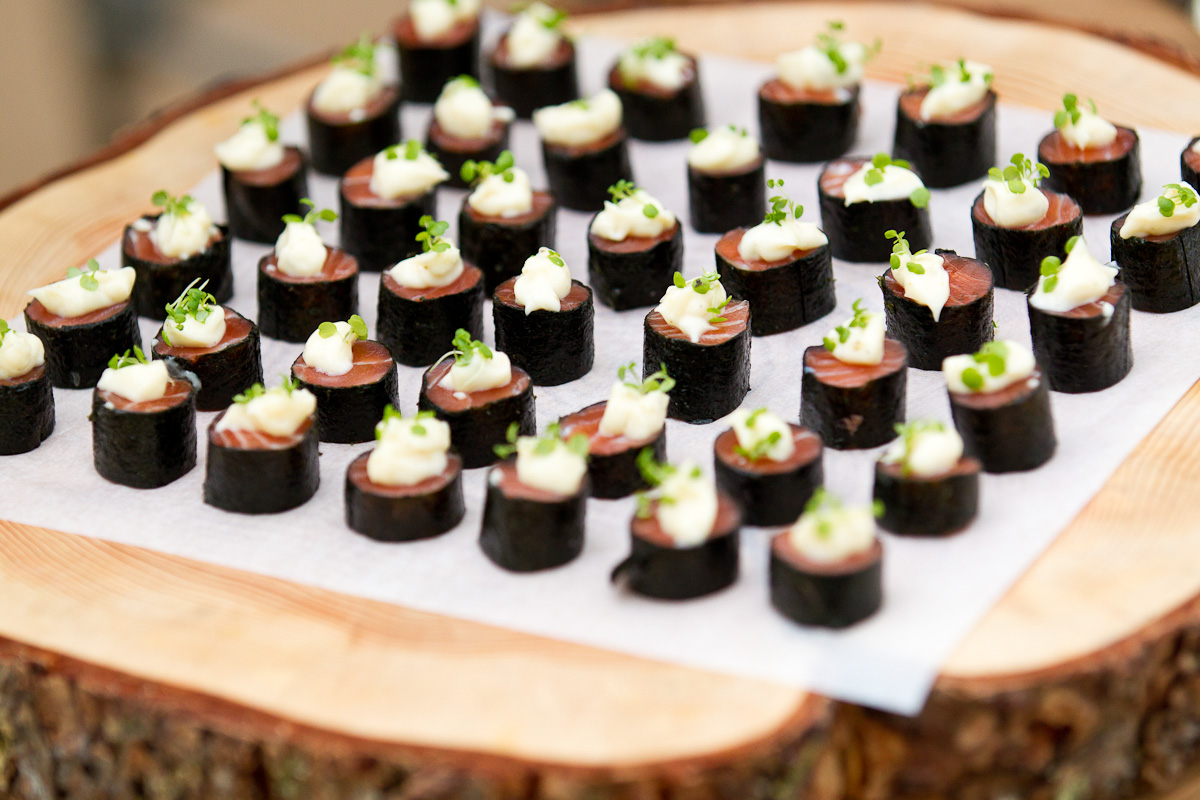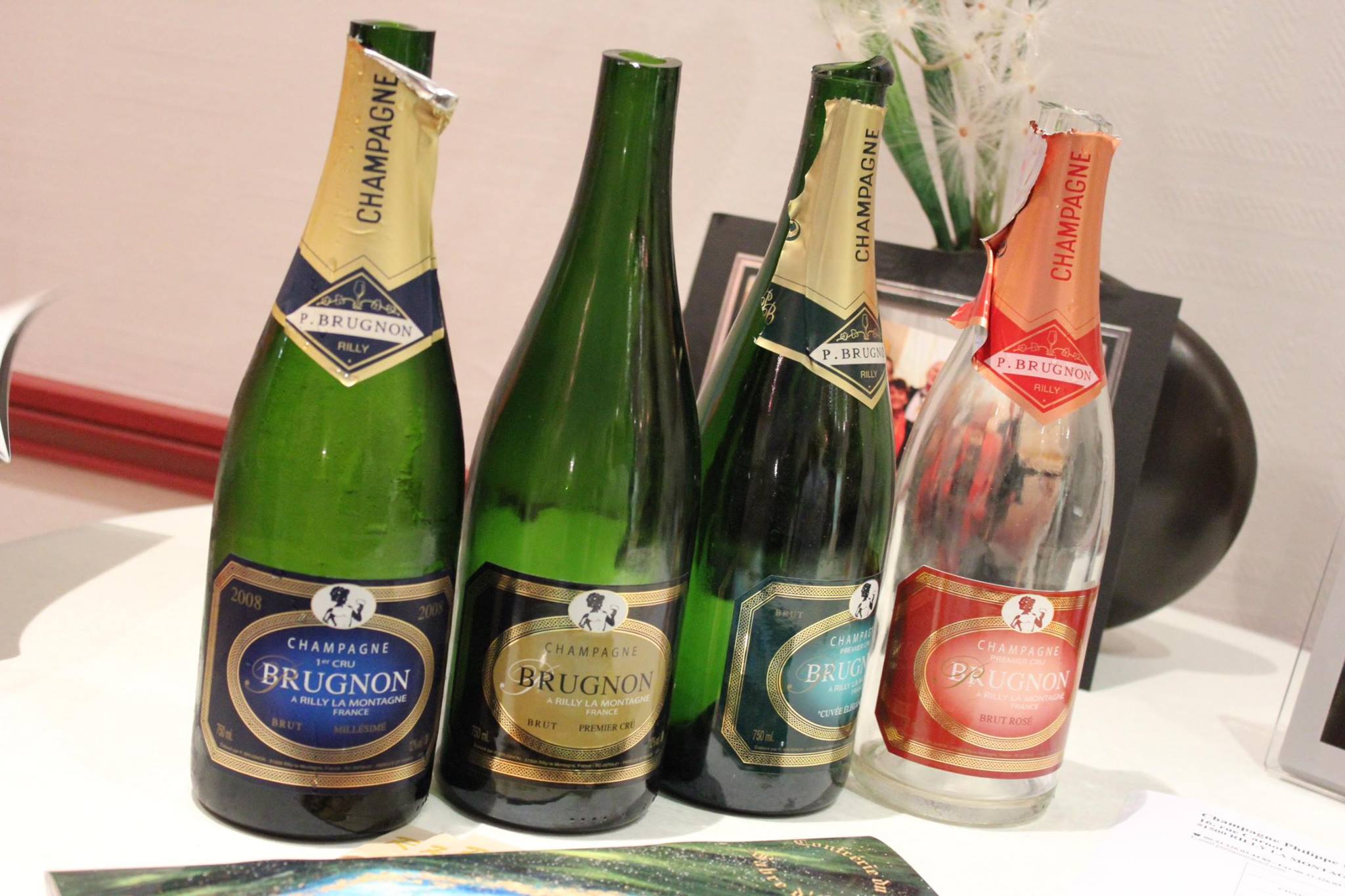Catering for the Raceday Crowd
One of the most unique ways to experience Flemington's Melbourne Cup Carnival is actually outside of the racecourse in the areas known as the Nursery, the Rails and the Domain. Outside of the Cup Carnival, these areas are just carparks, but during the eight-day event they transform into a giant street party, where the race-acquainted mingle with the social set and punting goes hand-in-hand with picnics. Members of the VRC apply for "sites" through a ballot, and pedestrian passes for the Nursery, Rails or Domain can be purchased for guests who aren't members to allow them to join the festive atmosphere. Unless specifically requested, sites are self-catering and allow guests to bring their own food and beverages for the day. But for a Nursery novice, the prospect of catering for 20 guests can be a daunting experience, and one which requires thorough planning and spreadsheet skills to get the job done right! Here are some points to consider when planning your site to ensure a successful Carnival day.1. Fancy or fun?The first question to answer is what kind of site will yours be? Take a look at your guest list to give you a guide: are you inviting the boss and his wife, will the in-laws be coming along, or will your site contain 19 of your closest mates? If you want to make a good impression, chances are you'll want an elegant site with tasty canapés, glasses of champagne and bottled brews, but if you're looking for a more casual affair you may be happier with an Aussie barbecue, tinnies and Passion Pop. It really is up to you, but make sure it's a space where your guests will be happy to stay - you don't want them to site-jump to your neighbours'!
Unless specifically requested, sites are self-catering and allow guests to bring their own food and beverages for the day. But for a Nursery novice, the prospect of catering for 20 guests can be a daunting experience, and one which requires thorough planning and spreadsheet skills to get the job done right! Here are some points to consider when planning your site to ensure a successful Carnival day.1. Fancy or fun?The first question to answer is what kind of site will yours be? Take a look at your guest list to give you a guide: are you inviting the boss and his wife, will the in-laws be coming along, or will your site contain 19 of your closest mates? If you want to make a good impression, chances are you'll want an elegant site with tasty canapés, glasses of champagne and bottled brews, but if you're looking for a more casual affair you may be happier with an Aussie barbecue, tinnies and Passion Pop. It really is up to you, but make sure it's a space where your guests will be happy to stay - you don't want them to site-jump to your neighbours'! 2. To cater or not to cater?Now you've decided on the tone of your site, it's time to start planning the food. If you want a fancy affair with minimum stress, it would be wise to choose a VRC recommended caterer from their approved list to cover everything, from the nibbles and bubbles through to the site set-up and even the hiring of wait staff. View the VRC's list of approved caterers on pages 12-13 of the 2013 Members' Carnival Guide.Unaccredited caterers (ie. those not on the list) are not permitted in the Nursery, Rails or Domain, but that doesn't mean you can't provide some quality canapés for your guests - sites are able to be catered "car boot/hamper style", meaning you can BYO as long as they arrive in your car.
2. To cater or not to cater?Now you've decided on the tone of your site, it's time to start planning the food. If you want a fancy affair with minimum stress, it would be wise to choose a VRC recommended caterer from their approved list to cover everything, from the nibbles and bubbles through to the site set-up and even the hiring of wait staff. View the VRC's list of approved caterers on pages 12-13 of the 2013 Members' Carnival Guide.Unaccredited caterers (ie. those not on the list) are not permitted in the Nursery, Rails or Domain, but that doesn't mean you can't provide some quality canapés for your guests - sites are able to be catered "car boot/hamper style", meaning you can BYO as long as they arrive in your car. 3. Too much or too little?The golden rule to remember when planning catering for an event such as this is always to over-cater on the food. You may think your guests want a beer-to-sandwich ratio of 4:1 (and it's true, they might), but waking up four days later with the same hangover due to lack of food and cheap booze (we'll get to that later) makes you a bad host. Always order more food than you think you need - remember, it's a long day (the first race on Derby Day is at 11:20am and the areas close at 6pm) and you can always eat the leftovers for breakfast the next day!4. Are you the next Masterchef?If you've already had your Derby Day outfit ready for several weeks and are quite adept at cooking, you may want to try your hand at catering your site yourself. The main points to consider when cooking for such an event are to provide a nice mix of food (don't just do hundreds of sausage rolls and quiches because pastry is your specialty), and ensure they aren't super messy to eat (bite-sized morsels are perfect, or food that can be eaten with just a fork is best if you want to plate-up). Taste.com.au has compiled a special Melbourne Cup recipe collection to assist with your raceday catering cookery.If you're barbecuing, make sure you've filled your gas tank (there are no electrical points at the sites and generators are prohibited) - running out of gas when the meat's only half-cooked is not an ideal situation to be in!5. Space and timeAs mentioned in the above point, it's a good idea to have a variety of food to keep your guests' appetites sated and it's also advisable to bring out different foods at different times throughout the day to ensure there's always something to soak up the alcohol.If starting super early (before the first race), it's a nice idea to begin the day with some brunch food: think mini pastries such as croissants, danishes and muffins with breakfast sandwiches (bacon and egg, and salmon and cream cheese) and slices of fruit. Keep some nibbles, such as corn and potato chips, dips and nuts, out on the tables throughout the day for guests to pick at. Bring out some heavier items around 1pm: sausage rolls and quiches, samosas, meat skewers, a variety of sandwich points and salads (pasta and rice salads are raceday winners), or get the barbecue cranking if that's your meal plan. After 3pm it's time to bring out the dessert selection: a variety of cheeses and crackers, mini scones (perhaps best to jam-and-cream them beforehand to lessen the mess), cupcakes, brownie squares and patisserie of the moment, macarons. Our favorites are from LuxBite, who have released a limited edition Champagne Cherry flavour (with the champagne being Moët et Chandon, oh la la!) in time for the Spring Carnival.
3. Too much or too little?The golden rule to remember when planning catering for an event such as this is always to over-cater on the food. You may think your guests want a beer-to-sandwich ratio of 4:1 (and it's true, they might), but waking up four days later with the same hangover due to lack of food and cheap booze (we'll get to that later) makes you a bad host. Always order more food than you think you need - remember, it's a long day (the first race on Derby Day is at 11:20am and the areas close at 6pm) and you can always eat the leftovers for breakfast the next day!4. Are you the next Masterchef?If you've already had your Derby Day outfit ready for several weeks and are quite adept at cooking, you may want to try your hand at catering your site yourself. The main points to consider when cooking for such an event are to provide a nice mix of food (don't just do hundreds of sausage rolls and quiches because pastry is your specialty), and ensure they aren't super messy to eat (bite-sized morsels are perfect, or food that can be eaten with just a fork is best if you want to plate-up). Taste.com.au has compiled a special Melbourne Cup recipe collection to assist with your raceday catering cookery.If you're barbecuing, make sure you've filled your gas tank (there are no electrical points at the sites and generators are prohibited) - running out of gas when the meat's only half-cooked is not an ideal situation to be in!5. Space and timeAs mentioned in the above point, it's a good idea to have a variety of food to keep your guests' appetites sated and it's also advisable to bring out different foods at different times throughout the day to ensure there's always something to soak up the alcohol.If starting super early (before the first race), it's a nice idea to begin the day with some brunch food: think mini pastries such as croissants, danishes and muffins with breakfast sandwiches (bacon and egg, and salmon and cream cheese) and slices of fruit. Keep some nibbles, such as corn and potato chips, dips and nuts, out on the tables throughout the day for guests to pick at. Bring out some heavier items around 1pm: sausage rolls and quiches, samosas, meat skewers, a variety of sandwich points and salads (pasta and rice salads are raceday winners), or get the barbecue cranking if that's your meal plan. After 3pm it's time to bring out the dessert selection: a variety of cheeses and crackers, mini scones (perhaps best to jam-and-cream them beforehand to lessen the mess), cupcakes, brownie squares and patisserie of the moment, macarons. Our favorites are from LuxBite, who have released a limited edition Champagne Cherry flavour (with the champagne being Moët et Chandon, oh la la!) in time for the Spring Carnival. 6. Herbivores and the health consciousI personally know diets generally go out the window when it comes to raceday dining, but some of your guests may have more willpower than you (or I) when it comes to snacking at the track. To truly be a good host, you should provide some healthier options for your guests when catering your site. One or two people will always surprisingly declare themselves to be vegetarians as well, and then there are those with allergies to consider (make sure you're aware which dishes have nuts, dairy and gluten in them).Vietnamese street food vendor Roll'd offers the perfect healthy raceday snack in the form of Roll'd Soldiers (their take on the rice paper roll), which are made in six flavours (from gourmet soft shell crab through to vegetarian favourite, tofu) and come with a choice of tasty dipping sauces. And best of all, the prawn and pork and tofu varieties are also gluten-free - way to impress the fussiest eaters! Prices start from $2.80 per soldier, or for $8.40 you can taste-test three flavours with a soft drink included.
6. Herbivores and the health consciousI personally know diets generally go out the window when it comes to raceday dining, but some of your guests may have more willpower than you (or I) when it comes to snacking at the track. To truly be a good host, you should provide some healthier options for your guests when catering your site. One or two people will always surprisingly declare themselves to be vegetarians as well, and then there are those with allergies to consider (make sure you're aware which dishes have nuts, dairy and gluten in them).Vietnamese street food vendor Roll'd offers the perfect healthy raceday snack in the form of Roll'd Soldiers (their take on the rice paper roll), which are made in six flavours (from gourmet soft shell crab through to vegetarian favourite, tofu) and come with a choice of tasty dipping sauces. And best of all, the prawn and pork and tofu varieties are also gluten-free - way to impress the fussiest eaters! Prices start from $2.80 per soldier, or for $8.40 you can taste-test three flavours with a soft drink included. 7. Budget bubbles vs. quality plonkWith the solids taken care of, it's time to sort out the liquid lunch portion of your catering. Unless you're putting on a generous, all-expenses-paid event, you'll probably have friends whispering in your ear requesting that ticket prices stay as low as possible so they can put most of their hard-earned on the quaddie. The one rule we've learnt when it comes to buying booze is not to skimp on quality. By this, I don't mean pay ridiculous amounts so you can have multiple cases of fancy labels, I just mean don't buy super cheap alcohol simply because it's super cheap. Buy beers and wine you know are decent, but not necessarily top shelf, and if you're buying something new, make sure you test it first - don't buy a full case of discounted French bubbles only to discover the cheapest Aussie sparkling at the local bottle-o is better.Keep a lookout for stockists that provide a discount for purchases made by the case, or wait until some of the major retailers put on a flash sale ("20% off six bottles or more" tends to happen a lot around Carnival time). You could even make a day trip of it and visit some local Victorian wineries to buy direct from their cellar doors - the Yarra Valley is a favourite destination of OTOT and not only provides a great selection of quality red and white wines, but also some outstanding sparklings and super ciders. Visit Yarra Valley Wine for a list of producers with cellar doors.And just like the food, it's a great idea to have a nice selection of beverages for your guests to enjoy, rather than just beers and champagne. Don't forget the soft drinks either, as a few cases of sodas and bottles of still water are always appreciated at some point during the afternoon, and are entirely necessary if Melbourne happens to turn on a beautiful spring day.If you're an experienced Nursery, Rails or Domain racegoer and have a great tip for successful site planning, please share your knowledge and leave a comment in the section below.Photo credits: www.vrc.net.au, www.novafm.com.au, www.thebiggroup.com.au, www.luxbite.com.au and www.rolld.com.au.By Lisa Tan
7. Budget bubbles vs. quality plonkWith the solids taken care of, it's time to sort out the liquid lunch portion of your catering. Unless you're putting on a generous, all-expenses-paid event, you'll probably have friends whispering in your ear requesting that ticket prices stay as low as possible so they can put most of their hard-earned on the quaddie. The one rule we've learnt when it comes to buying booze is not to skimp on quality. By this, I don't mean pay ridiculous amounts so you can have multiple cases of fancy labels, I just mean don't buy super cheap alcohol simply because it's super cheap. Buy beers and wine you know are decent, but not necessarily top shelf, and if you're buying something new, make sure you test it first - don't buy a full case of discounted French bubbles only to discover the cheapest Aussie sparkling at the local bottle-o is better.Keep a lookout for stockists that provide a discount for purchases made by the case, or wait until some of the major retailers put on a flash sale ("20% off six bottles or more" tends to happen a lot around Carnival time). You could even make a day trip of it and visit some local Victorian wineries to buy direct from their cellar doors - the Yarra Valley is a favourite destination of OTOT and not only provides a great selection of quality red and white wines, but also some outstanding sparklings and super ciders. Visit Yarra Valley Wine for a list of producers with cellar doors.And just like the food, it's a great idea to have a nice selection of beverages for your guests to enjoy, rather than just beers and champagne. Don't forget the soft drinks either, as a few cases of sodas and bottles of still water are always appreciated at some point during the afternoon, and are entirely necessary if Melbourne happens to turn on a beautiful spring day.If you're an experienced Nursery, Rails or Domain racegoer and have a great tip for successful site planning, please share your knowledge and leave a comment in the section below.Photo credits: www.vrc.net.au, www.novafm.com.au, www.thebiggroup.com.au, www.luxbite.com.au and www.rolld.com.au.By Lisa Tan













